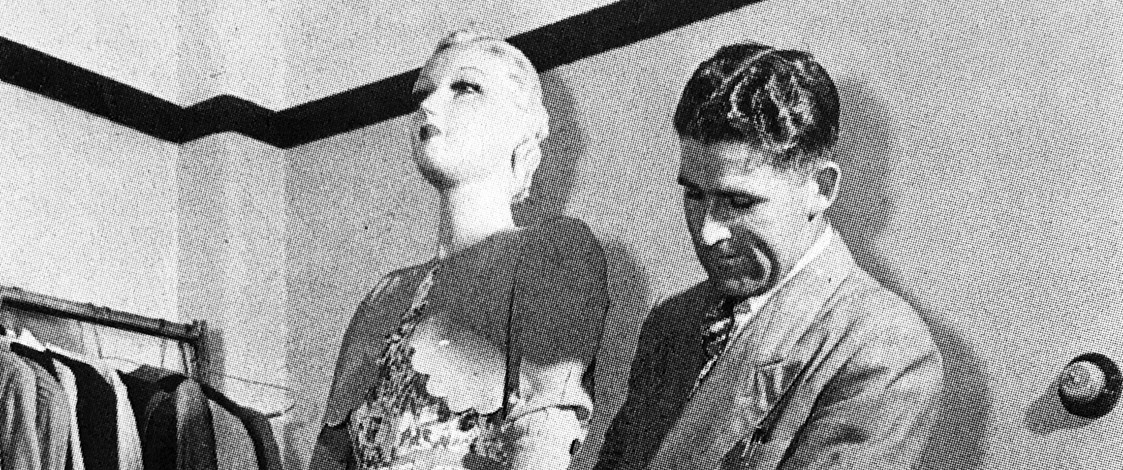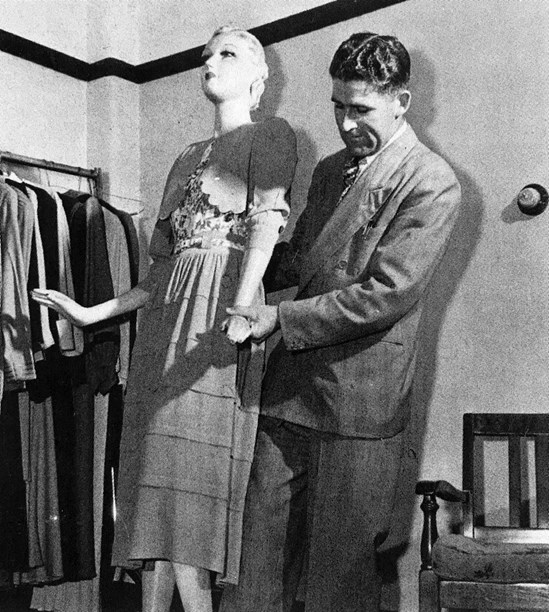Stories
Fred R Allen
1946-1989 (label)

Before rugby was a professional sport, players - even All Blacks - had to earn an income elsewhere. Fred Allen, who captained and later coached the national team, juggled his sporting career with ownership of a women's clothing label.
On his return from the Second World War, Fred Allen and two other stars of the Kiwis side had been head-hunted by the highly esteemed Wigan Warriors Rugby League Club. "Wigan offered me a signing-on fee of £4500, which, quite honestly, struck me as mind-blowing," said Fred. "Making up my mind was a real struggle, but in the end I really didn’t want to leave New Zealand." All three players thanked Wigan and turned down the offer. Fred did go on to play for the All Blacks, but it was still 50 years before the players would be paid a salary.
Fred collected a lump sum of £250 for his years of military service, which he said, with a rueful smile, was hardly generous. Now he needed to find himself a job. His thoughts turned to his experience at Ballantynes in Christchurch. He started as an errand boy at the department store when he was 16. His salary was 17 shillings and sixpence a week, most of which he gave to his mother. "The rest of it I spent on the things kids enjoy, like comics and Eskimo Pies," Fred said.
In the mid-1930s, Ballantynes was a dignified and disciplined establishment in which the staff conformed to a strict dress code. Women were required to wear black dresses with white collars and flat-heeled shoes. Their stocking seams had to be perfectly straight and they were banned from painting their fingernails or wearing jewellery of any kind. All male staff had dark suits and white collars and were instructed to wear hats when entering or leaving the store. That applied to even the lowliest of juniors like Fred.
"One of my main jobs when I began in furnishings was lugging rolls of material down Lichfield Street to the factory. If I’d been caught without my hat, even if I was only going across the road, I’d have been in deep trouble."
Ballantynes’ training system involved its youngest employees moving from department to department to gain an insight into the entire business. This rotation policy meant that Fred spent some time learning the art of window-dressing and it was during this time he discovered just how strong Ballantynes was on modesty.
When displaying female underwear, great care was taken to show it in the most discreet way. The life-like plaster models of shapely women were decorously hidden under dressing-gowns with only the tiniest hint, a peep-show glimpse, of the garment beneath. Male plaster models received similar treatment. The idea of them being on public show in woollen long-johns was far too vulgar for Ballantynes and they, too, were half hidden under dressing-gowns.
A decade later when he was looking for a job, Fred thought he ought to make use of what he learnt at Ballantynes and do something in fashion. "Maybe I should even have a crack at starting my own little business," he thought. One of Fred’s friends had already established himself in the rag trade and needed someone to supply fabric belts for the garments he was making. Fred hunted around Auckland for cheap premises and found an unused storeroom below street level in Courthouse Lane for 15 shillings a week. "It was a bit of a dungeon, about the size of a one-car garage, but it was good enough for me to make a start."
At first it was just him making the belts, but soon he took on an assistant machinist to meet the growing demand. "Then I realised I could expand. At that time, just after the war, there were restrictions on what people could import but, as a returned serviceman, I could obtain a licence to import materials. And if I did that I could start making frocks as well as belts."
That was the thinking behind the Fred R Allen women’s outer-garment manufacturing enterprise, launched with a borrowed £1000. It was to be the centre of his life for just over 40 years. "But money was tight in those early days and I did sometimes wonder if I hadn’t been stupid not to go to Wigan."

Fred Allen adjusts a mannequin in his label's showroom. Image © Fred Allen Collection.
Because of the design and quality of Fred’s garments it wasn’t long before leading department stores such as Milne & Choyce and Smith & Caughey’s in Auckland were stocking the Fred R Allen label.
By then the business had expanded from the little dungeon to a larger office and showroom in Lorne Street where Fred helped the staff with all the daily tasks such as packing dresses, sweeping floors and tidying the workroom. He knew instinctively that success was based on teamwork.
Then came another shift to even bigger premises in Airedale Street where the firm was fortunate to have the services of one of New Zealand’s top designer-cutters. Under Betty Kendall’s supervision 20 machinists produced immaculately cut, high-class clothing for women. "Our garments were non-dating without any gimmicks," said Fred. "They were not thrown out at sales because they’d still be fashionable the following year."
Fred worked hard to build up the business. Each year when he wasn’t tied up with rugby, he travelled at least twice through the North and South Islands to show new lines and solicit orders. His proudest moments as a salesman came when orders for his garments were regularly received from his former bosses at Ballantynes. "Naturally, when I kept an appointment with their buyers I was extra certain that there wasn’t a speck on my polished shoes and, of course, I carefully brushed my hat before getting out of the car."
Fred was nearly 70 before he closed the clothing factory. "Nearly all businesses were having a bit of a struggle in the late 1980s but I had two good reasons for not retiring earlier. First I had to consider my loyal staff who badly needed their jobs and then I had to consider myself. So many mates about my age had suddenly stopped work and the next thing they’d put their cues in the rack. I was determined that wouldn’t happen to me."
Text excerpt from Fred the Needle: The untold story of Sir Fred Allen, by Alan Sayers and Les Watkins. Published by Hodder Moa.